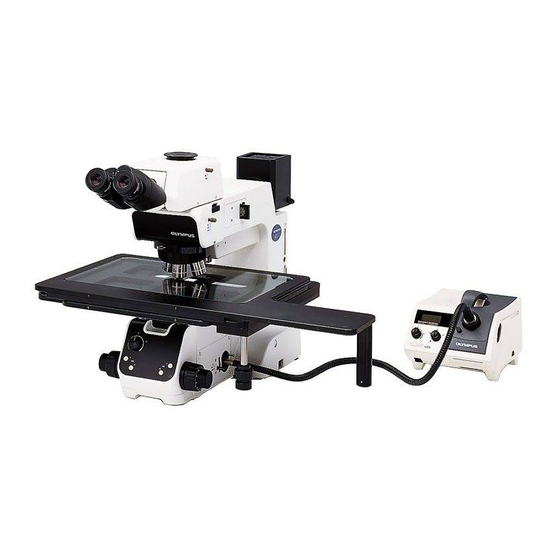Olympus MX61L Manuel d'assemblage - Page 9
Parcourez en ligne ou téléchargez le pdf Manuel d'assemblage pour {nom_de_la_catégorie} Olympus MX61L. Olympus MX61L 49 pages. 200mm/300mm compatible semiconductor/fpd inspection microscopes

1
Getting Ready
²
Fig. 3
2
Maintenance and Storage
1. To clean the lenses and other glass components, simply blow dirty away using a commercially available blower and wipe
gently using a piece of cleaning paper (or clean gauze).
If a lens is stained with fingerprints or oil smudges, wipe it gauze slightly moistened with commercially available absolute
alcohol.
Since the absolute alcohol is highly flammable, it must be handled carefully.
Be sure to keep it away from open flames or potential sources of electrical sparks –– for example, electrical
equipment that is being switched on or off. Also remember to always use it only in a well-ventilated room.
2. If any part of the equipment (other than glass components) gets dirty, with it with a clean cloth.
If the party is extremely dirty, do not attempt to use organic solvents to clean it; instead, use a soft, lint-free cloth slightly
moistened with a diluted neutral detergent.
3. Never disassemble any part other than instructed of the microscope. This could result in malfunctions or reduced
performance.
4. When not using the microscope, keep it covered with a dust cover. Make sure the lamp housing is cool before covering
the microscope.
5. When disposing of the microscope. Check the regulations and rules of your local government and be sure to
observe them.
3
Applicable Standards
1. These devices are in compliance with or certified by the following standards.
2. Although these devices are designed for use in industrial environments, their full performances may not be manifested if
they are not operated properly. Be sure to handle them properly as instructed in this manual.
These devices are designed for use in industrial environments (Class A devices).
Using them in a residential environment may affect other equipment in the environment.
CE marking
This device complies with the requirements of both directive 89/336/EEC concerning electromagnetic compatibility
and directive 73/23/EEC concerning low voltage. The CE marking indicates compliance with the above directives.
1. Do not use the microscope where it is subjected to direct sunlight, high
temperature and humidity, dust or vibrations. (For the operating conditions,
refer to chapter 8, "SPECIFICATIONS " in the Instruction Manual.)
2. A microscope is a precision instrument. Handle it with care and avoid
subjecting it to sudden or severe impacts. Never attempt to rotate the
motorized revolving nosepiece by hand; otherwise, the gear or other parts
may be damaged.
3. When moving the microscope, detach the observation tube, stage, lamp
housing and specimen to reduce the total system weight, and then
insert the two provided carrying rods @ firmly into the left and right side
panels. Two persons are needed to carry the microscope; one should
hold the front holding section ² and a carrying rod and the other person
should hold the rear holding section ³ and the other carrying rod. Be
sure to move the microscope cautiously. (The microscope frame weight
is about 30 kg, or 66 lbs.)
³
}After movement, remove the carrying rods, and either have the customer
retain them without losing or attach them to the two screw holes on the
@
rear of the microscope. Attach the provided screw hole caps to the screw
holes left by removing the carrying rods.
# Do not change the position of the microscope by sliding it on the
desktop surface; otherwise, the rubber feet will be damaged.
4. Be sure to attach the transport clamping plate(s) to the stage before
transporting it.
MX61/MX61L
6
